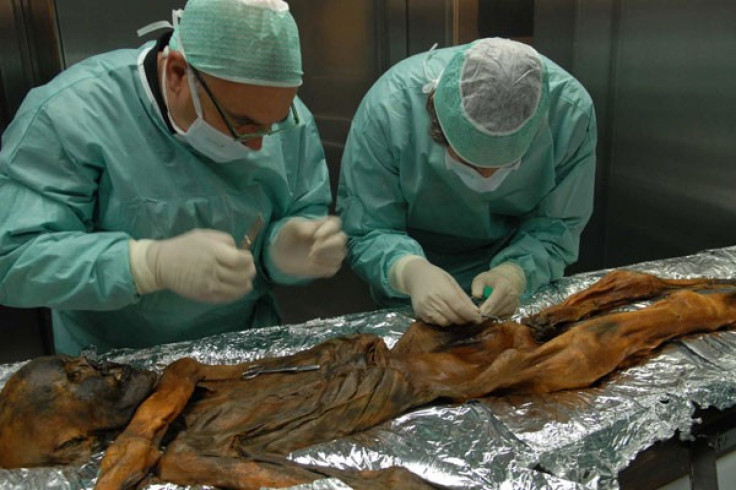New Evidence In 'Ice Mummy? Murder Mystery

After a two decades-long investigation, researchers discovered that Ötzi, the 5,300-year-old ice mummy, found preserved under ice in the Alps in 1991, indeed died shortly after being shot with an arrow. The findings, published in the Journal of the Royal Society Interface on Wednesday, are the latest pieces of evidence in the world's oldest murder mystery.
Scientists initially believed Ötzi to be a weary, ancient traveler who succumbed to exhaustion and died of exposure the elements. However an X-ray revealed Ötzi to have an arrow lodged in his back, indicating that he was attacked while running away, causing some to dub the case the earliest known murder mystery, according research by Northwestern University.
The arrow wound was so severe it would have been fatal even if Ötzi had access to modern medicine, according to a 2007 article by the Guardian. Ötzi also had evidence ofa head injury he likely sustained after falling due to being shot, according to Northwestern University.
There has been a great deal of public interest in solving the curious case of the frozen ancient corpse, Craig Smuda, a researcher from Northwestern University, said in a paper about the ice mummy.
The true reasons behind Ötzi's death will forever remain hidden, not simply because the physical evidence is incomplete, but because physical evidence can only tell us part of his story, he said. With Ötzi and his killers both long dead and without any sort of record from his preliterate society, there is no way that we can determine the motivations behind his murder. Though we may make suppositions based on the physical evidence, the minds of the people of that era are forever closed to us.
Scientists have long debated whether Ötzi died shortly after he was injured or whether he survived for some time, but the latest findings put a close to that chapter of the mystery. Researchers discovered fibrin, a protein that is found in fresh wounds, in the arrow wound, indicating that Ötzi died shortly after he was shot, according to the study.
The fact that we found some of the fibrin confirms that he didn't survive the arrow for a long period, Albert Zink, study author and a biological anthropologist at the European Academy of European Academy of Bozen/Bolzano, told CBS News. It's good to have, because there were still some people [thinking] that maybe he could have survived the arrow shot for a few hours, a few days.
The researchers found the fibrin while checking for preserved blood in Ötzi's wound. Previous examinations of Ötzi did not reveal any blood, but the latest scan used a technique called atomic force microscopy, which created a 3D map of the arrow wound on Ötzi's back by dragging a tiny metal tip across it. Using atomic force microscopy, the researchers found preserved red blood cells, the oldest known example of blood cells.
Up to now there had been uncertainty about how long blood could survive -- let alone what human blood cells from the Chalcolithic period, the Copper Stone Age, might look like,, Zink said in a statement.
Researchers found that the blood cells look very similar to human blood cells from today, according to the study.
They have the typical form, this kind of doughnut-like shape of red blood cells, Zink told LiveScience. The dimensions are the same in modern-day samples, so we were really quite sure these were red blood cells that had been preserved for 5,000 years.
The findings could help with modern-day police investigations, researchers said.
It is very interesting to see that the red blood cells can last for such a long time, Zink told the Chicago Tribune. This will also open up possibilities for forensic science and may help lead to a more precise determination of the age of blood spots in crime investigations.
Hikers discovered Ötzi in the Oeztal Alps in 1991. Researchers have been able to piece together quite a bit about Ötzi since his initial discovery. Tests revealed that Ötzi was 45-years-old, 5 and a half feet tall (1.65 meters) and weighed 110 pounds (50 kg) at the time of his death.
Ötzi's genetic makeup was mapped earlier this year and researchers revealed a near-complete picture of the ice mummy in a study published in February. It showed that he had Lyme disease and was genetically predisposed to cardiovascular disease despite the fact that he was not overweight and would have exercised frequently. Hardening of the arteries, a symptom of heart disease, was also seen.
The findings also revealed that Ötzi had brown eyes and hair, blood type O and was lactose intolerant.
The evidence that such a genetic predisposition already existed in Ötzi's lifetime is of huge interest to us, Albert Zink, a researcher who worked on Ötzi and head of the Institute for Mummy Research, said in a statement. It indicates that cardiovascular disease is by no means an illness chiefly associated with modern lifestyles. We are now eager to use these data to help us explore further how these diseases developed.
© Copyright IBTimes 2024. All rights reserved.











